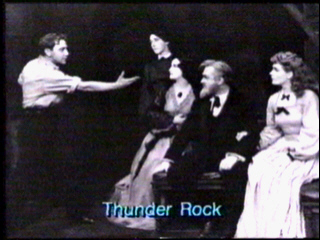
--Thunder Rock--


Image courtesy of Jack Randall Earles
Cast
Frances Farmer
Luther Adler

Mordecai Gorelik's imaginative lighthouse setting for the Group Theatre's Thunder Rock captured the spirit of Robert Ardrey's fanciful theme even more fully than did the actors, the direction, or the play itself.
Thunder Rock approached the problem of the individual's relation to the world at another angle from that of Kingsley's play. Robert Ardrey's hero is not a victim of spiritual isolation, but a man who has lived a full life and found it wanting; his repudiation is political, not psychological. Charleston had been a newspaperman, a foreign correspondent, a man of ideas and ideals. The last years had seen the destruction of all his hopes for humanity. He withdraws into his ivory tower, which in this case is a lighthouse on Lake Michigan, where his imagination re-creates the past. The ghosts of 1839, whom he evokes in his anguish of mind, prove to him that no one need despair, since no one can tell what seeds of future growth lie dormant in the most destructive and apparently hopeless present. His faith restored, he goes back again into active life after sending his reluctant phantoms back to their watery graves.
Mr. Ardrey, who has not been seen on Broadway since Casey Jones and How to Get Tough About It earned him critical praises on Broadway two years ago, has again proved himself a thoughtful and stimulating writer, able to handle even such recalcitrant material as ectoplasm with ingenuity. His ghosts have the great advantage of being conceived as figments of one man's imagination, thereby gaining in theatrical viability. The point is cleverly emphasized by the device of closing the whole lighthouse scene within a solid, skull-like cyclorama when Charleston is alone with his spooks. When real people are present - the inspector, Charleston's friend, the helper - the structure, designed by Mordecai Gorelik with exciting visual beauty, seems to stand in the open. Sky and drifting clouds are seen on either side, there is the noise of the sea and wind, the wide sunlit world is at the door.
The Group Theatre has given its usual meticulous care to this, the first production of its season. Elia Kazan's direction provided marked rhythms both for the play as a whole and for the individual acting. Movement and gesture underscore the imaginative angle of the ghost scenes in particular as does the effective lighting, while Paul Morrison's costumes add warmth to the scene. The acting, as always with the Group Theatre, is sincere and sustained throughout, though Luther Adler, working with his usual intensity, seem too florid and self-conscious even for the non-realistic moments.
Opened - November 14, 1939 | Closed December 2, 1939
Review published in Theatre Arts - January 1940

Screen capture from Elia Kazan: A filmmaker's journey


This page last updated 2001, Aug 13